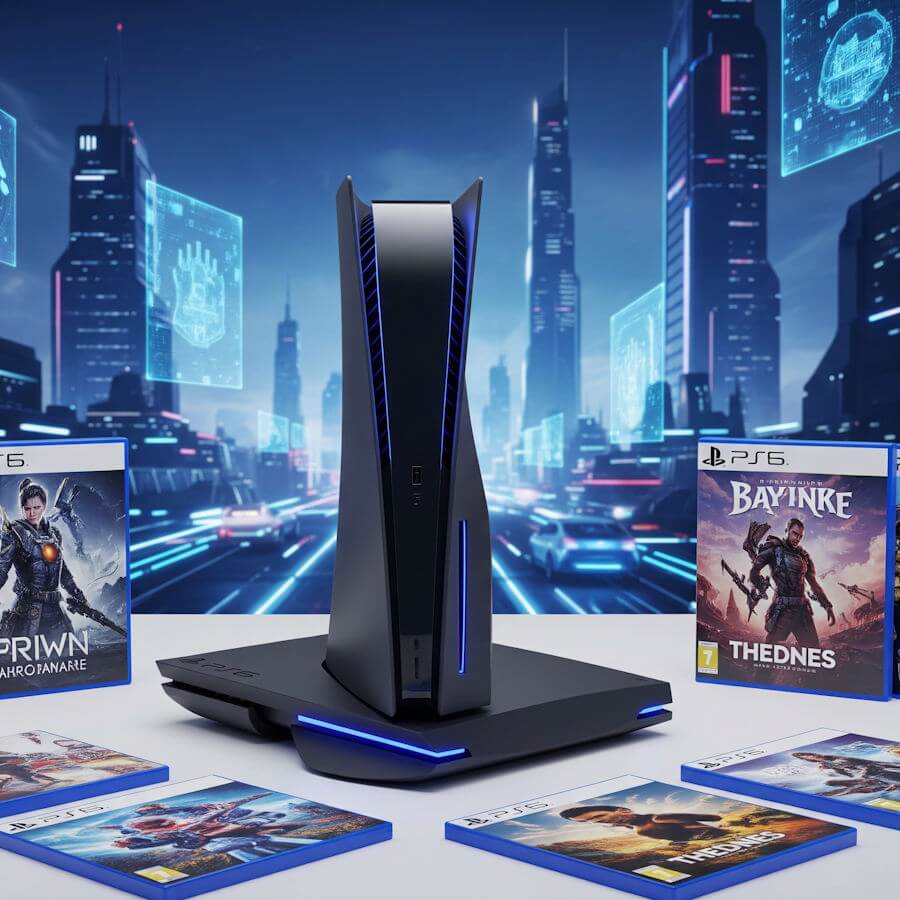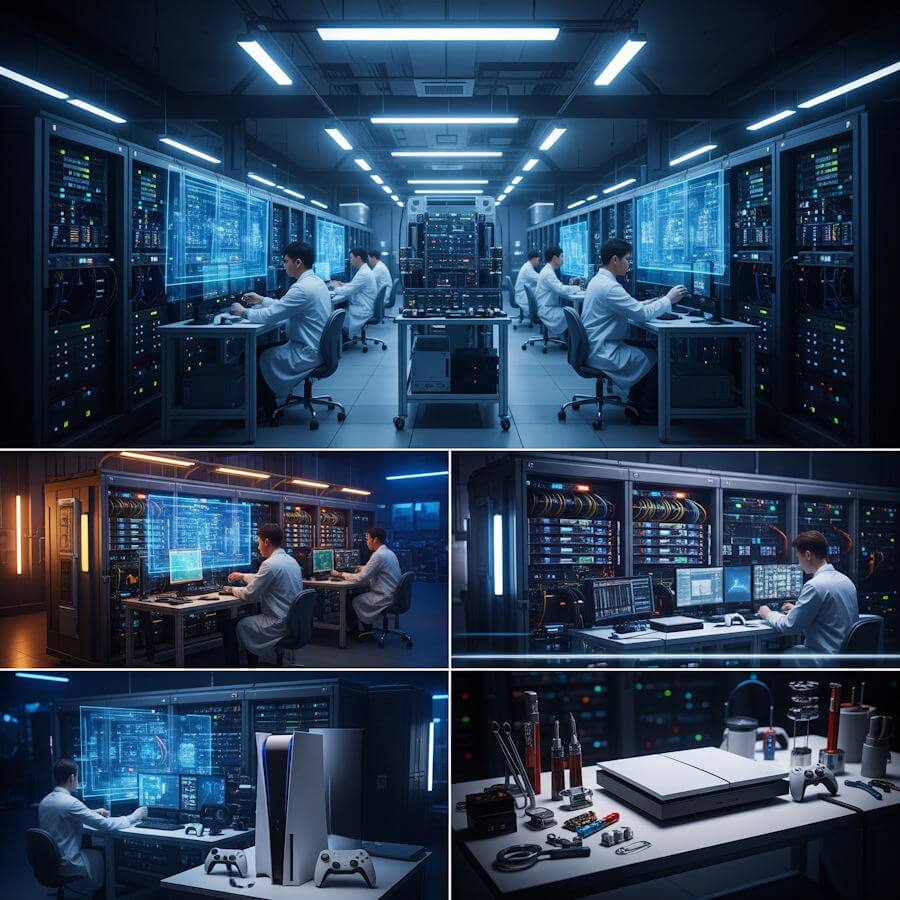The gaming industry has undergone remarkable transformations over the past few decades, with each console generation bringing forth significant advancements in technology and gameplay experiences. Among the most anticipated developments is the imminent arrival of the PlayStation 6, the successor to the widely successful PlayStation 5. With the PlayStation 6, enthusiasts are eager to witness the innovations that are set to redefine the gaming landscape.
While an official release date has yet to be confirmed, speculation suggests that the PlayStation 6 could launch in the latter half of this decade. This follows a production cycle consistent with previous PlayStation models, which typically see new iterations released approximately six to seven years apart. The PlayStation 5, launched in late 2020, has laid the groundwork with its cutting-edge features such as ultra-fast SSD technology, 4K graphics support, and immersive haptic feedback. Such advancements establish a high benchmark for the upcoming console.
The anticipation surrounding the PlayStation 6 is palpable within the gaming community. Gamers look forward to potential enhancements in graphics fidelity, processing power, and overall interactivity. Innovative features such as cloud gaming, AI-driven game development, and expanded virtual reality capabilities are expected to be at the forefront of this new console. The foundational success of prior models like the PlayStation 4 and PlayStation 5 has contributed to high standards, and many fans are enthusiastic about what the new generation will bring.
As we approach the anticipated launch, discussions about the PlayStation 6 revolve around its potential to elevate gaming experiences to new heights, building on the legacy of its predecessors while offering fresh and engaging content for both new and seasoned gamers alike. With excitement building, it is clear that the PlayStation 6 is poised to become a central player in the future of gaming.
Advanced Hardware Specifications
The upcoming PlayStation 6 is anticipated to feature cutting-edge hardware specifications that promise to redefine the gaming landscape. Central to this advancement is the processing power, which may utilize a next-generation CPU architecture. This new design is expected to provide substantial improvements in performance and efficiency, allowing for more complex game mechanics and richer, more immersive narratives. Utilizing advanced manufacturing processes, the CPU could achieve higher clock speeds while consuming less power, which is crucial for sustaining performance over long gaming sessions.
Graphics capabilities are also set to experience a major enhancement with the PlayStation 6. Rumors suggest the integration of advanced graphics processing units (GPUs) powered by ray tracing technologies, offering lifelike lighting, shadows, and reflections that dramatically elevate visual fidelity. These visual improvements are supported by increased memory bandwidth and capacity, which could be significantly higher than that of its predecessor. This increase in memory is expected to allow for more detailed textures and larger, more expansive game worlds, thereby enhancing player experiences.
Furthermore, there is growing speculation about the potential for incorporating quantum computing elements within the PlayStation 6’s architecture. This revolutionary technology could enable unparalleled processing speeds and allow games to incorporate complex algorithms dynamically. Additionally, enhanced cloud gaming features, such as seamless integration with multiplayer functionalities and improved network latency, could provide users with a consistent, high-quality gaming experience, bridging the gap between local and cloud-based gaming. The combination of these advanced hardware specifications will likely cultivate an enriched gaming experience, steering the future of interactive entertainment.
Revolutionizing Gaming Experiences with VR and AR
The advent of Virtual Reality (VR) and Augmented Reality (AR) technologies has already begun to reshape the landscape of interactive entertainment, and the anticipated PlayStation 6 is poised to further accelerate this transformation. As the gaming community anticipates its release, the integration of sophisticated hardware and cutting-edge software innovations will define the console’s approach to immersive experiences. With enhancements in VR and AR capabilities, players are expected to experience gameplay in extraordinary new ways.
Current VR systems deliver engaging environments by completely enclosing players in digital worlds, facilitating unprecedented levels of interaction. The PlayStation 5 has already made significant strides in this domain, notably through the PlayStation VR headset. However, the PlayStation 6 is likely to introduce an upgraded headset featuring higher resolution displays, improved field of view, and enhanced motion tracking. These advancements promise to create a more realistic visual and physical experience, allowing users to navigate complex environments with impressive fluidity.
Moreover, the incorporation of AR technology can augment the gaming experience outside the predefined virtual realms. By overlaying digital information onto the physical world, AR can create dynamic interactions that blend reality and fantasy. This technology could revolutionize how games are played, transforming everyday spaces into battlegrounds, adventure landscapes, or puzzle scenarios while fostering cooperation and social engagement among players.
Projections for the PlayStation 6 also hint at innovations that include intuitive gesture controls and haptic feedback systems that simulate touch and movement. Such advancements would enhance the sense of agency and immersion, further dissolving the barriers between the player and the game world. In essence, the future of gaming on the PlayStation 6 seems not only promising but also poised to elevate the standards of how players relate to and engage with interactive content.
Innovations in Game Development
The future of gaming heralds a new era of innovation, particularly with the advent of the PlayStation 6. Central to this evolution will be advancements in game engine technology that will elevate both production efficiency and gameplay experience. Developers are anticipated to leverage next-generation engines that support real-time ray tracing, enhanced physics simulation, and more dynamic environments. These capabilities will allow for visually stunning games that also maintain high performance, thus enriching player engagement and immersion.
Another pivotal aspect of the forthcoming gaming landscape is the integration of artificial intelligence (AI). AI is poised to provide personalized gaming experiences, adapting to individual player behaviors and preferences. For example, AI-driven NPCs (non-player characters) could react intelligently and dynamically to player actions, creating a more engaging and unpredictable environment. Furthermore, machine learning algorithms could analyze gameplay data to offer tailored suggestions or difficulty adjustments, enhancing the overall playability of each title.
Developers are also expected to embrace new tools and platforms that facilitate content creation. Cloud gaming technologies are anticipated to become more prevalent, allowing for expansive, persistent online worlds where players can collaborate or compete without the constraints of traditional hardware limitations. Additionally, the rise of cross-platform development tools will enable developers to reach a broader audience by simplifying the process of creating games that are playable on multiple devices, including mobile platforms and VR headsets.
In this transformative landscape, the role of developers will evolve, as they harness these groundbreaking technologies to create more engaging and interactive content. By focusing on innovation, the future of game development alongside the PlayStation 6 promises to redefine how players experience games and interact with virtual worlds.
Enhanced Connectivity and Social Features
The future of gaming consoles, particularly with the anticipated launch of PlayStation 6, hints at a transformative leap in online connectivity and social features. This evolution will likely prioritize seamless cross-platform play, enabling players to engage with friends and gaming communities across various platforms. Such connectivity reflects a significant trend, as gamers increasingly demand the ability to interact and collaborate regardless of their chosen console.
Moreover, enhanced social interaction tools are expected to be a cornerstone of the PlayStation 6 ecosystem. This will encompass improved voice and video chat functionalities, allowing players to communicate effortlessly during gameplay. With features like live streaming and in-game social hubs, users can share their experiences in real-time, fostering a sense of community that extends beyond individual gaming sessions. The incorporation of these tools is crucial in creating a more immersive and interactive gaming environment.
The role of online communities will also take center stage as the PlayStation 6 aims to enhance social connectivity. These communities, driven by shared interests and collaborative gameplay, can significantly influence the gaming experience. The integration of user-generated content and community-driven events is expected to amplify engagement, encouraging players to connect, collaborate, and compete on a larger scale. Notably, this shift aligns with the growing recognition that gaming is not just a solitary activity but rather a social experience that thrives on interaction.
In conclusion, the advancements in connectivity and social features anticipated with PlayStation 6 will likely redefine how gamers interact within the digital landscape. By embracing cross-platform play and enhancing social tools, the PlayStation 6 aims to create a more connected gaming world, where communities can flourish and players enjoy a rich, collaborative experience. This evolution will ensure that the future of gaming resonates with the ever-evolving needs of its diverse audience.
Sustainability and Eco-friendliness in Gaming
The gaming industry has witnessed rapid advancement over the last few decades, not only in terms of technology but also in its increasing awareness and responsibility towards environmental issues. As the demand for gaming devices continues to rise, the need for sustainability in gaming technology becomes more pressing. The upcoming PlayStation 6 is expected to set new benchmarks in integrating eco-friendly practices across the board, from production to energy consumption and the overall lifecycle of the console.
Manufacturing processes significantly contribute to the carbon footprint of electronic devices, and therefore, eco-friendly approaches are essential. With the PlayStation 6, Sony is anticipated to adopt sustainable materials, reducing reliance on plastic and non-recyclable components. This move not only minimizes environmental impact but also aligns with global efforts to combat pollution and conserve resources. Furthermore, the trend towards circular economy principles may lead to initiatives such as take-back schemes, allowing consumers to recycle their old consoles responsibly.
Energy consumption is another critical aspect of sustainability in gaming. The PlayStation 6 is expected to be embedded with energy-efficient technologies, such as advanced power management systems and the use of renewable energy sources during production. These improvements aim to reduce the overall environmental footprint during its operational phase. By promoting energy-saving features that decrease power consumption during gameplay and standby modes, Sony can ensure that the user experience does not come at the expense of ecological health.
In addition to manufacturing and energy considerations, the broader gaming ecosystem is also impacted by digital practices. The PlayStation 6 may lead the charge towards a more digitized library, minimizing the environmental implications associated with physical game production and distribution. Overall, the industry’s responsibility to prioritize sustainability represents not only an ethical obligation but also an opportunity to innovate and drive positive change within the gaming community.
Game Streaming and Subscription Services Evolution
The gaming industry is experiencing a seismic shift, primarily driven by the rise of game streaming and subscription services. As the landscape evolves, it is imperative for platforms like PlayStation 6 to adapt accordingly. The introduction of high-speed internet and advancements in cloud technology have set the stage for an unprecedented transformation in how players access and enjoy video games. This transition is no longer a mere trend but a foundational change in the gaming culture.
PlayStation has already made strides towards embracing subscription-based models, with services such as PlayStation Plus offering a library of games for a monthly fee. The anticipated PlayStation 6 is expected to expand on this concept, potentially introducing more extensive partnerships with third-party developers and content creators. This could lead to exclusive titles becoming available on subscription platforms, making high-quality gaming experiences more accessible to a broader audience. As a result, players might enjoy the flexibility of playing demanding titles without the immediate need to purchase expensive hardware.
One of the critical aspects of this evolution is the enhanced accessibility of games. For players in regions with limited access to high-end gaming consoles, streaming services can offer a legitimate avenue to experience cutting-edge games on lower-end devices, including smart TVs and mobile phones. This democratization of gaming not only enhances the user experience but also significantly expands the potential player base. Moreover, the interactivity and social components fostered by subscription services can lead to an enriched community experience.
As the PlayStation 6 approaches its launch, one can anticipate the company leveraging these evolving trends in game streaming and subscriptions. By staying at the forefront of this evolution, PlayStation will likely redefine how gamers interact with their favorite franchises, solidifying its place in the future of gaming.
Anticipated Game Titles for PlayStation 6
The gaming community is abuzz with excitement regarding the upcoming release of the PlayStation 6, which is expected to introduce a range of innovative features and enhancements. Alongside the new hardware, various game titles are anticipated to make their debut, either at launch or shortly thereafter. Major franchises are set to deliver sequels or spin-offs that have become beloved within the gaming culture.
One notable title that has generated considerable buzz is the next installment of the iconic “Final Fantasy” series. Following the success of “Final Fantasy VII Remake,” fans are eager to experience what Square Enix has in store. This franchise consistently shows a commitment to high-quality storytelling and cutting-edge visuals, elements that are expected to be amplified on the PS6’s advanced hardware.
Similarly, the “Gran Turismo” series continues to redefine racing games, and there are strong indicators that “Gran Turismo 8” may launch alongside the PS6. With its reputation for realism and an extensive collection of vehicles, it appeals to both casual players and hardcore racing enthusiasts. Fans are likely to be excited about the potential integration of augmented reality features, enhancing the immersive racing experience.
Moreover, we can expect new entries from popular franchises such as “God of War,” and “The Last of Us.” Sony has shown a trend towards developing blockbuster titles that offer rich narratives coupled with cutting-edge gameplay mechanics. Additionally, indie titles may also see increased visibility, as advancements in the PlayStation 6 could facilitate a broader array of game genres, from narrative-driven experiences to innovative gameplay concepts.
With developments in virtual reality and cloud gaming, it is anticipated that genres such as role-playing and simulation will continue to gain traction. As such, the PlayStation 6’s library is expected to cater to diverse gamer interests, ensuring that both veteran and new players find compelling content upon its release.
Conclusion: The Future Awaits
As we look towards the future of gaming, the anticipation surrounding the PlayStation 6 reflects a significant shift in technological innovations and player experiences. The expected enhancements, ranging from superior graphics and faster load times to revolutionary gameplay mechanics powered by artificial intelligence, mark a new era in the gaming industry. These advancements will not only redefine how games are developed and played but also enhance the level of immersion available to players.
The integration of virtual reality (VR) and augmented reality (AR) technologies into the gaming ecosystem is poised to create more engaging and lifelike gaming experiences. Additionally, the increased focus on cloud-based gaming services is likely to allow gamers access to high-quality titles without the need for extensive hardware. This move can democratize access to gaming, ensuring that more individuals can participate in this digital realm.
Moreover, the PlayStation 6 is set to promote a more robust social gaming environment, with features that encourage collaboration and competition among players. Enhanced online multiplayer experiences will likely allow for more seamless interaction and community-building, further binding gamers together. As these developments unfold, the implications for the gaming industry as a whole are immense, suggesting increased innovation that can attract new audiences and sustain the fascination of long-time players.
In essence, the future of gaming, particularly with the anticipated launch of the PlayStation 6, signals a transformative period filled with excitement. As technology advances and new possibilities emerge, the gaming community is invited to engage in discussions about the prospective changes awaiting them. The next generation of gaming promises to not only elevate entertainment but also redefine user interaction, bridging the gap between virtual worlds and reality.





